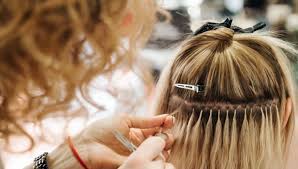
Hair loss can be a difficult and emotional experience, especially for those dealing with alopecia. While some people embrace their natural beauty, others may look for ways to restore their confidence by adding volume and length to their hair. One of the best solutions for alopecia patients is cheap professional hair extensions. However, not all hair extensions are suitable for thinning hair. If you are looking for the best methods, this guide will help you understand your options and find the best fit for your needs.
Why Hair Extensions for Alopecia?
Hair extensions can be a great way to enhance your look and regain self-confidence. They add volume, length, and style to your existing hair, making it easier to achieve your desired look. Many alopecia hair salon experts recommend extensions because they can be applied in ways that protect fragile hair while still giving natural-looking results. The key is to choose the right method based on your hair condition and lifestyle.
- Clip-In Hair Extensions
Clip-in hair extensions are a temporary and affordable solution for those with mild to moderate hair thinning. These extensions come in wefts with small clips attached, making them easy to clip onto your natural hair without causing damage.
Pros:
- Easy to apply and remove
- No professional help needed
- Cost-effective and reusable
Cons:
- Not suitable for very thin or patchy hair
- Clips may feel uncomfortable for some people
- Tape-In Hair Extensions
Tape-in extensions are one of the most recommended methods for people with thinning hair. These extensions have a thin, adhesive tape that sticks to the natural hair. They lie flat against the scalp, making them almost invisible.
Pros:
- Lightweight and comfortable
- Blends well with natural hair
- Can last 6-8 weeks with proper care
Cons:
- Requires professional application and removal
- Adhesive may irritate sensitive scalps
- Micro Link Extensions (Micro Beads)
Micro link extensions, also known as micro bead extensions, are small wefts of hair attached to natural hair using tiny beads. The beads are clamped shut to hold the extensions in place without using heat or glue.
Pros:
- No glue or tape involved
- Long-lasting (up to 3 months)
- Can be adjusted as hair grows
Cons:
- Not suitable for fragile hair
- Requires regular maintenance
- Can be uncomfortable if not applied correctly
- Halo Hair Extensions
Halo hair extensions are a great non-permanent option that does not require any glue, tape, or beads. These extensions are attached to a transparent wire that sits on top of the head like a halo, blending seamlessly with natural hair.
Pros:
- No damage to natural hair
- Quick and easy to wear
- Comfortable and lightweight
Cons:
- Not suitable for very short hair
- May slip out if not adjusted properly
- Sew-In (Weave) Extensions
Sew-in extensions involve braiding the natural hair and then sewing hair extensions onto the braids using a needle and thread. This method is usually recommended for individuals with
- Keratin Bond Extensions
Keratin bond extensions use individual strands of hair attached to natural hair with a keratin-based adhesive. This method is Suitable for various hair types
Finding the Right Hair Extension Method
Choosing the right hair extension method depends on several factors, including the severity of hair loss, lifestyle, budget, and hair type. It is always best to consult with a professional at an alopecia hair salon to determine which method suits you best.
If you are looking for cheap professional hair extensions, some options like clip-in and tape-in extensions may be more affordable, while others, like keratin bonds, require a larger investment. It’s essential to balance cost with quality to ensure you get long-lasting results.
Caring for Your Hair Extensions
To keep your hair extensions looking great and lasting as long as possible, follow these care tips:
- Gentle Washing: Use sulfate-free shampoo and conditioner to avoid stripping the extensions of moisture.
- Avoid Excess Heat: Limit heat styling to prevent damage to both the extensions and your natural hair.
- Brush Carefully: Use a soft-bristle brush or a special extension brush to avoid pulling on the extensions.
- Regular Maintenance: Visit your alopecia hair salon for maintenance and adjustments as needed.
- Sleep with Care: Tie your hair in a loose braid or ponytail before sleeping to prevent tangling.
Conclusion
Hair extensions can be a life-changing solution for alopecia patients, offering confidence and a way to enhance natural beauty. Whether you choose clip-ins, tape-ins, micro-links, or another method, selecting the right type is crucial to achieving the best results. Consult with a professional to find the best option that suits your hair condition and budget.
If you are searching for cheap professional hair extensions, there are many options available that provide quality results without breaking the bank. Remember to prioritize hair health, maintenance, and proper application to ensure your extensions look beautiful and last long.
Embrace your beauty, explore your options, and enjoy the transformation that hair extensions can bring





Leave a Reply